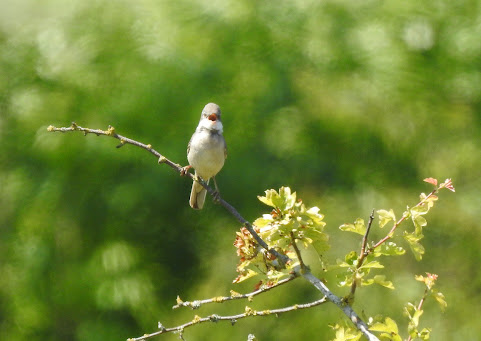The day treated us to a bright sunny morning with a light north-easterly and news of a potential Circle year-tick from yesterday. All to play for then.
The new bird was a Ringed Plover. Context is everything. Anyway we weren't running towards the flash field. Instead we ambled to where the ringing had taken place last week, and probably yesterday, and quickly confirmed that the Garden Warbler was still singing away. We also added a somewhat distant singing Grasshopper Warbler. I filmed the Garden Warbler while we could still hear the Gropper, and I believe I can just about hear it on this extract.
Quite a few House Martins were heading back and forth overhead, and on reaching the pool/scrapes field we discovered why. They were taking advantage of some wet mud which is all that remains of one of the scrapes. Nest-building was clearly in full swing.
 |
| House Martins |
We counted at least 14, so that means seven pairs as a minimum, slightly up on recent years. There were also one or two Swallows having a look.
We finally got to the flash field where the recent drought has largely drained the nearest flash. At least 13 Lapwings and 16 Black-headed Gulls were standing around, and eventually we located three Little Ringed Plovers. Then, to my relief, we found the Ringed Plover. It seemed to be a first summer bird, lacking an orange-based bill, or particularly bright legs.
 |
| Ringed Plover |
Inevitably Dave and I were turning our attention towards insects, or rather the lack of them. We did manage a reasonable selection of dragonflies, moths, and butterflies, but the numbers seemed low. Is this just the early-June dip which is sometimes commented on where butterflies are concerned? I hope so, but we both thought there were fewer bees, flies, and all the other stuff which seemed so obvious in previous years. Perhaps last year's hot summer has knocked insect populations, or maybe we're just wrong.
 |
| Common Whitethroat |
We still got plenty of year-ticks. Two Common Blue butterflies, a Brown Argus, and a Large Skipper were butterfly ticks, two Hook-tipped Grass Veneers Crambus lathoniellus, and a Yellow-faced Bell Notocelia cynosbatella were moth year-ticks. The latter may have been a site first for me, but I'm still trying to put a list together.
 |
| Hook-tipped Grass Veneer |
 |
| Notocelia cynosbatella |
 |
| Brown Argus |
Dragonflies on the wing included a Black-tailed Skimmer, and two Emperors.
If less is more, then it was another pretty decent visit to the patch.
No comments:
Post a Comment